We knew it would happen! We predicted it would happen! And now it has happened! The annual late Christmas present from ICAO that always seems to get lost in the post and then turns up in January – an updated version of the NAT Doc 007.
NAT Doc 007 is the main go-to guidance doc for ops over the North Atlantic. All the specifics about how to operate your aircraft safely through the complex airspace of the region are here. The updated version is valid from Jan 2023. You can download it from ICAO at the source here, or click on the image below:
The summary of changes by ICAO
They always post a little summary at the start, so here is a screenshot of it for you.
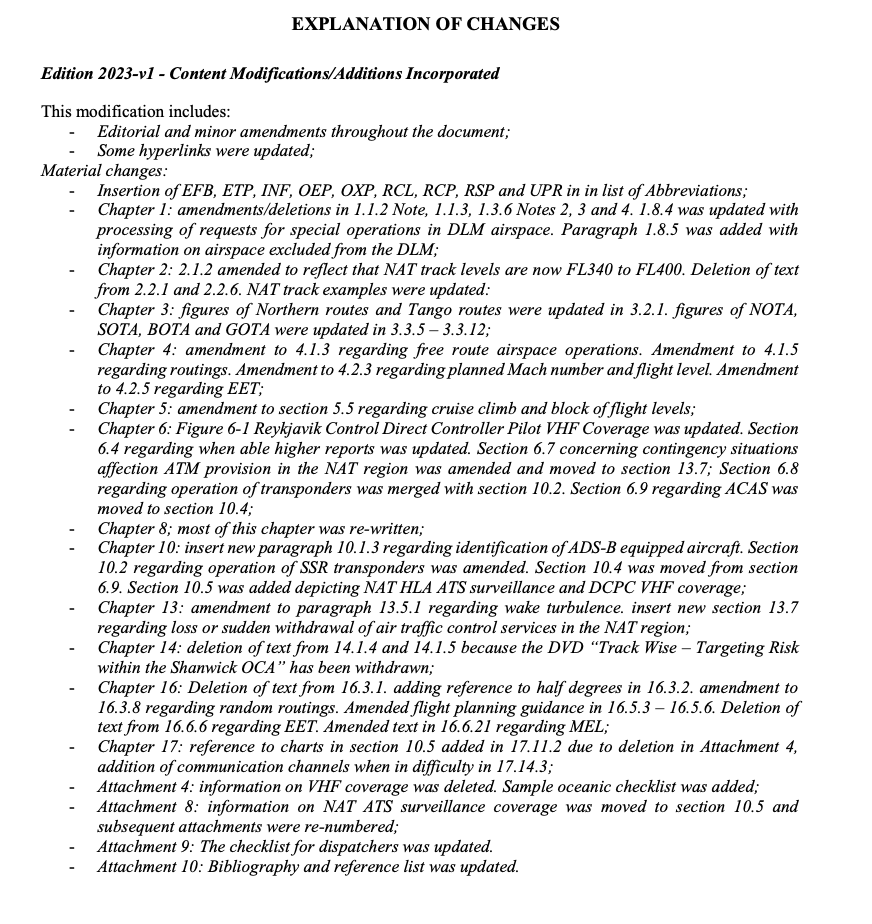
Hideous
The summary of changes by us
Hideous indeed. So here is a less hideous (but possibly less informative) summary of the changes we spotted as we scrolled through the 174 pages of Nat Doc 007 V.2023-1. We decided to go chapter by chapter so you can head on in and read the full info direct from the NAT Doc 007 itself if it interests you to.
Chapter 1: Operational Approval & Aircraft System Requirements for Flight in the NAT HLA
Something about Target Levels of Safety
This is probably of interest if you’re a huge fan on the “Where you all went wrong this year” updates from the NAT HLA. They set the ‘maxima’ to 5×10-9 fatal accidents per flight hour, which I think means one in every 500 millionth or something.
OK, moving on.
Equipment related stuff
This is all stuff you probably know already, but they have updated and edited it so we figured we would recap on the important bits as well.
RVSM: Two handy links have been added in providing you info on RVSM equipment requirements.
Along with a reminder that because the NAT HLA is RVSM, you need to be RVSM approved to fly in it.
Clocks: Make sure yours is accurate and synchronised to an ‘acceptable’ UTC time signal before heading off. A lot of aircraft have clocks that can only be updated on the ground so check before you fly.
LRNS: Do you fly an aircraft with only 1 LRNS (and it’s a GPS)? Then its got to be approved in accordance with FAA TSO-C129 or whatever the EASA equivalent is (it is ETSO-C129a).
CPDLC: Don’t have FANS 1/A “or equivalent”? (we still aren’t totally sure what “or equivalent” really means!) Then you can still request to climb or descend through the NAT DLM airspace, and there are some exceptions for specific flights where you might even get let in –
- Scientific research type flights (probably not any of you)
- If your equipment fails on you post take off then you might be ok, talk to ATC
- If you’re in the NAT DLM and your equipment fails then you might be re-cleared (to move you out of the way of less dysfunctional folk), but they aim is to try and keep you on the plan you were already on
They have also clarified three specific areas where datalink is not required. This one has been bugging us for a long time with previous NAT Doc updates! Datalink exempt areas have always been these three:
- Airspace north of 80° North
- New York Oceanic East flight information region (FIR);
- Airspace where an ATS surveillance service is provided by means of radar, multilateration and/or ADS-B, coupled with VHF voice communications as depicted in State Aeronautical Information Publications (AIP), provided the aircraft is suitably equipped (transponder/ADSB extended squitter transmitter).
We’ve never understood what number 3 means – until now. The new NAT Doc now specifically lists where these areas are: a chunk of airspace over Iceland/Greenland, one over the Azores, and another in Bodo. They have even provided some maps and coordinates too.
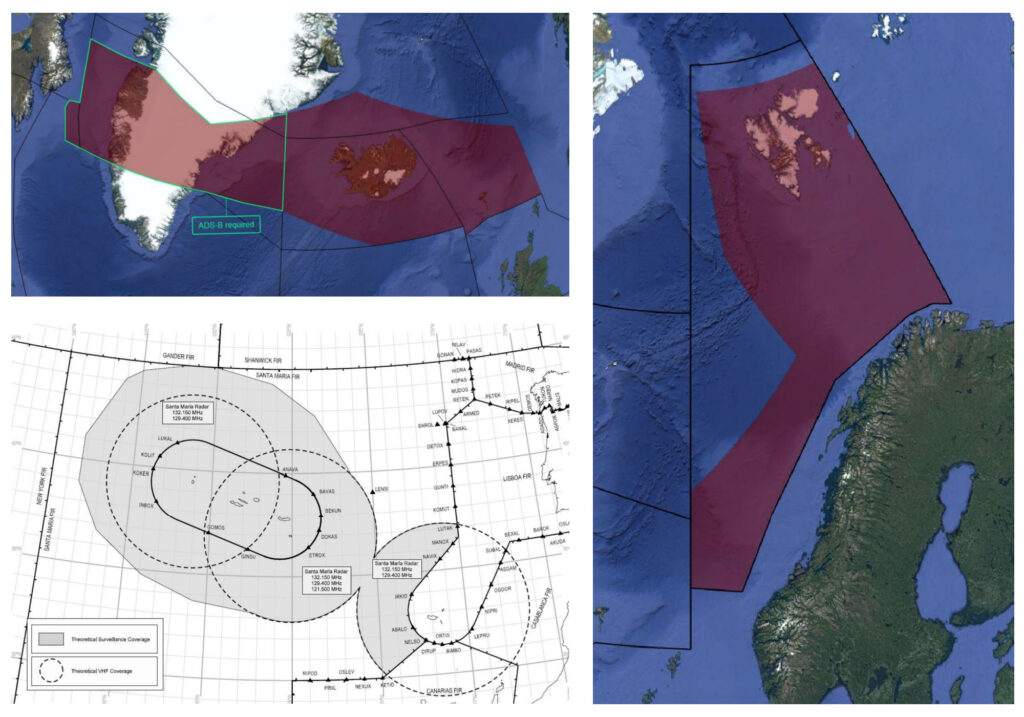
Datalink exempt areas (the others in the NAT are: airspace north of 80° North, and the NY Oceanic FIR).
Update 3 APR 2023: There have been some changes to the boundaries of the datalink exempt airspace in the northern bit of the North Atlantic. This used to extend down south to SAVRY, but now only goes as far as EMBOK. So now you need datalink in the NAT oceanic airspace over Greenland controlled by Gander. Check this post for more info.
Chapter 2: The OTS
More reminders on things you know rather than any major new stuff.
- If you want to fly on the half-spaced PBCS Nat Tracks, you need RNP 4 approval but also RCP240/RSP180 equipment (and a state approval). That’s been the case for a while.
- You will also get messages saying “SET MAX UPLINK DELAY VALUE TO 300 SEC”. Do it.
- Nat Tracks are now from FL340 to FL400 inclusive. (Remember, Nat Tracks at FL330 and below were removed back in March 2022).
- If there is a particularly strong westerly jetstream then Shanwick will post a split westbound structure which means you might see two adjacent landfall and exit points at the Eastern NAT boundary for the daytime eastbound flow to use.
Chapter 3: Routes, Route Structure, Transition areas
They have updated the maps and info on the bits adjacent to the NAT HLA (your NOTA, BOTA, SOTA and GOTAs).
Chapter 4: Flight Planning
Doc 7030 is the main reference for flight planning in the NAT (and state AIPs). There are little bitty edits here but nothing new.
Chapter 5: Oceanic Clearances
A cruise climb can be requested if you’re fat and heavy and want to climb little more flexibly as your drop weight (burn fuel). ATC will do their best to accommodate this.
Chapter 6: Comms and Position Reporting Procedures
The “When Able Higher” report is no longer mandatory in the New York OCA. The only place it’s still required is when entering the Santa Maria OCA.
There’s also an update in this section about where the VHF stations are. Remember, when you’re on VHF you might not be talking direct with an ATSU. You can request a direct patch-through on HF or GP/VHF if you need it (and are on Iceland Radio or Shanwick Radio).
They’ve updated the big pink blob map to show where you should be able to get VHF coverage. Here it is.
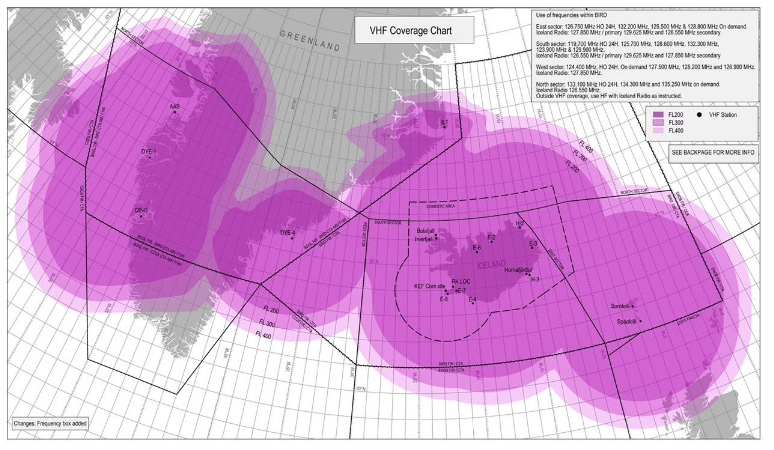
Big pink blob map.
INTERESTING SIDE-NOTE: Now, DON’T PANIC, they haven’t put this in the updated Doc, but we saw it in the ‘proposed changes that might one day come in’ document… You currently need 2 LRCS and one of them must be HF (generally). This isn’t changing, but if you lose HF then you might (when they make the change) be able to enter so long as you have two other LRCS systems that are appropriate for the route. Exciting…
Chapter 7: Application of Mach Number Technique
Don’t get confused between RNP10 and RNAV 10. Not the same thing, but they can’t be bothered to correct everyone all the time on it so they’ve added a note saying this.
Also, don’t make Gross Navigation Errors. They ain’t good and will be investigated. Here’s the tip: if you’re on a random route, a single digit error in latitude could put you pretty darn near another aircraft so be careful!
Chapter 8: Flight Ops & Navigation Procedures
They have provided a very helpful Checklist. This chapter goes into full detail on it, and Attachment 4 has it nicely summarised.
Chapter 9: RVSM
FAA AC 91-85 has all your info on state approvals.
Chapter 10: ATS Surveillance Services
This is the ATS Surveillance Services chapter. They’ve updated the guidance on your squawking.
When you’ve been in the NAT HLA for 30 minutes you should set your squawk to 2000 (the domestic controller on the other side might not want you to use the same one). But there are some exceptions this:
- While in the Reykjavik ACC stick with your assigned code because you’re in radar control (in the south eastern part) and they don’t want you to change it until you’re told to.
- All eastbound flights routing Reykjavik – Shanwick – Scottish should squawk 2000 after 10 minutes.
- Routing on T9 squawk 2000 10 minutes after passing BEGAS (northbound) or LASNO (southbound).
- Routing on T290 squawk 2000 10 minutes after ADVAT or GELPO
ADS-B is only mandated on T9 and T290.
Chapter 11: Monitoring of Aircraft Systems & Flight Crew Performance
This chapter has a nice list of things to report/things ATC will report:
- Erosions of longitudinal separation between aircraft, within the NAT HLA, of 3 minutes or more (so if you find yourself getting to close).
- Anytime you have to do something to prevent a GNE.
- Lateral deviations from cleared route of less than 25 NM.
- Discrepancies of 3 minutes or more between an ETA/ATA at a waypoint.
- Occasions when an operator is suspected of not being in possession of an NAT HLA/RVSM approval.
- Diversions or turnbacks, noting in particular whether the appropriate published contingency procedure was correctly adopted.
- ACAS RAs.
- Wake turbulence reports.
- Incorrect application of the SLOP (e.g. a left offset).
Chapter 12: Procedures in Event of Navigation System Degradation or Failure
No noteworthy newness (none that we could find, at least).
Chapter 13: Special Procedures for In-flight Contingencies
This covers all your loss or sudden withdrawal of ATC services. So it is basically a mini summary of Doc 006 and also covers the ‘What to do it?’ situations.
They have also updated the contact info for SATVOICE. So here you go –
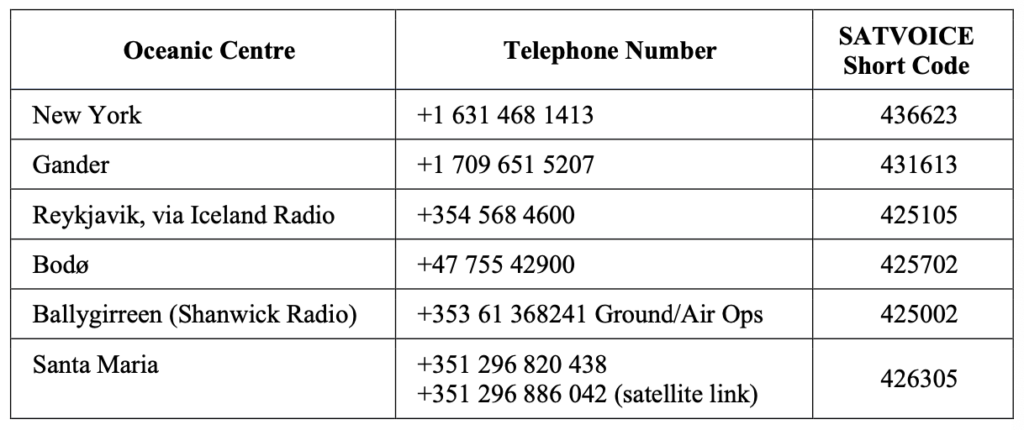
Chapter 14: Guarding Against Common Errors
Updated to list recent ones.
Chapter 15: The Prevention of Lateral Deviations from Track
No newbies.
Chapter 16: Guidance for Dispatchers
There is some updated info on planning codes. Take a look.
Chapter 17: Flight Operations below the NAT HLA
So this stuff all applies for flights FL280 and below. Actually an interesting read! There aren’t any massive changes here though. Mainly these one:
- Reminder the SLOP should be right of track.
- They re-iterate that they still haven’t managed to get a decent map of VHF coverage of the North Atlantic. If we want one, we should go scratching around in State AIPs (where we still won’t find any – we’ve looked).
- If you’re in trouble, you don’t just have VHF 121.5 to turn to. Also try 123.450, SATVOICE, or “any other communication device you may have”.
End of the Doc: All the attachments
Mostly forms and stuff, but Attachment 4 is that handy sample checklist we mentioned and Attachment 9 is an equally handy checklist for dispatchers covering equipment and what have you.
Phew, done!
Another year, another NAT Doc. Well, let’s hope so – they do sometimes release a sneaky Version 2 update some time around July/August. But for now, we can relax.
Did you spot any big updates in this new NAT Doc? Haven’t read it yet and don’t want to scroll to the top of the page to find the link again? No worries, just click here. If you do spot anything significant that we missed, please let us know! You can email us at news@ops.group
More on the topic:
- More: What’s Changing on the North Atlantic
- More: Timeline of North Atlantic Changes
- More: Blue Spruce Routes Are Gone (But You Can Still Fly Them)
- More: Updated FAA Oceanic Guides
- More: NAT Airspace Closures: Formidable Shield 2025
More reading:
- Latest: Mexico Customs Surprises: Pills, Vapes, and Laptop Rules
- Latest: Greenland NAT Alternates: Dec 2025 Update
- Latest: Crossing the Quiet South: From Australia to Argentina
- Safe Airspace: Risk Database
- Weekly Ops Bulletin: Subscribe
- Membership plans: Why join OPSGROUP?




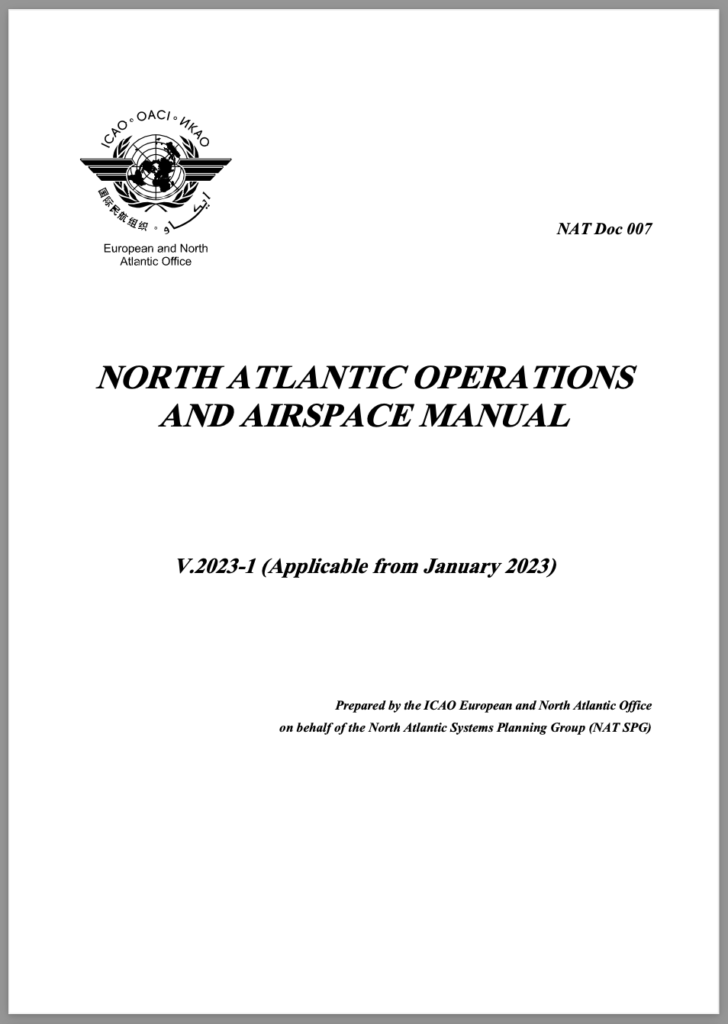
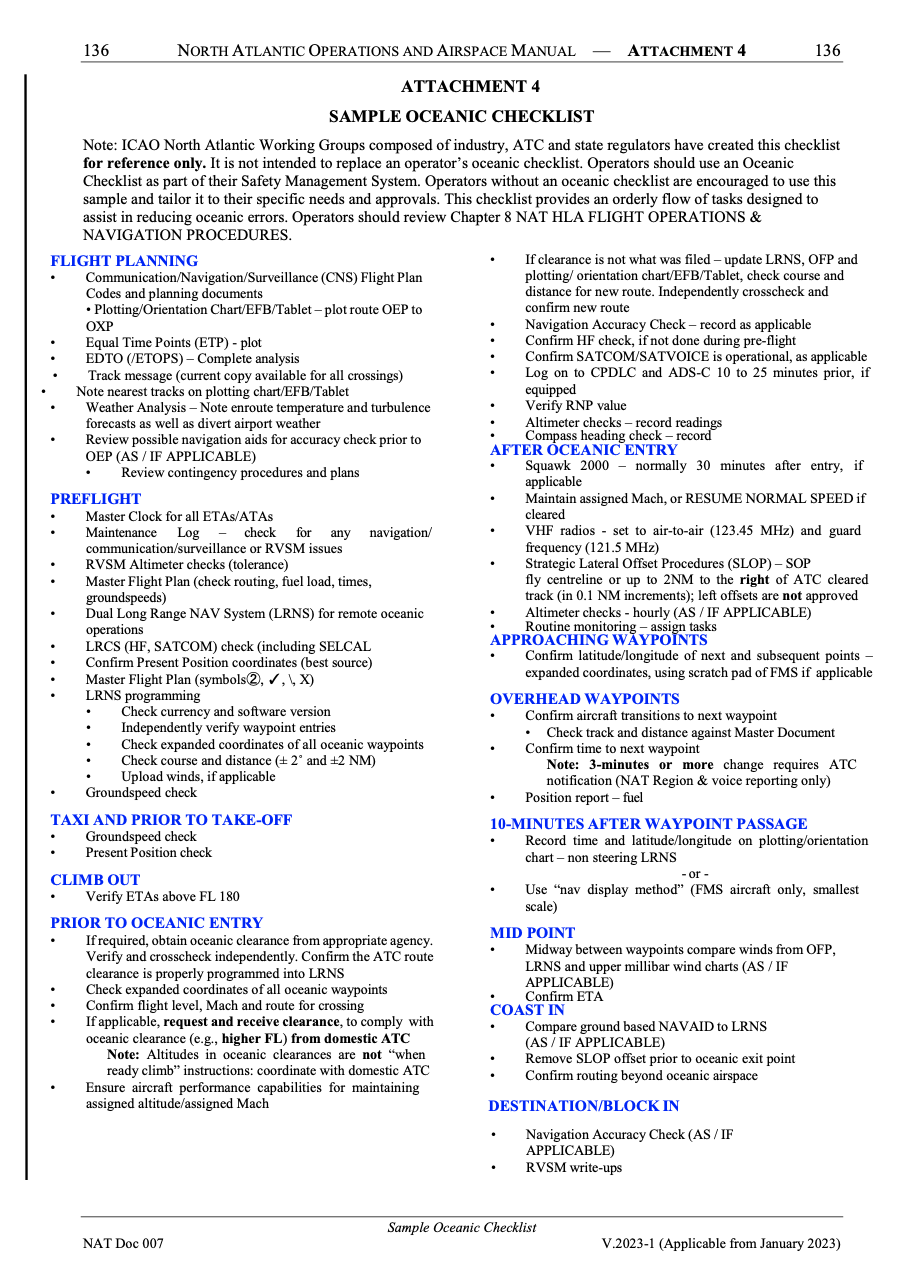







 Get the famous weekly
Get the famous weekly 






Is it really mandatory for airlines to have an oceanic checklist for aircrews to use? It appears to be so in the NAT OPS bulletin 2017-005.
Thank you for doing this review btw. Any particular reason they didn’t include GOTA (Gander Oceanic Transition Area) as Datalink exempt since it has VHF, ADS-B, Radar Coverage and is Class A Airspace? This was already confirmed in a previous Ops Group article and NAVCanada acknowledged it as well.
Yep, think that little green map they included in the Doc is not 100% correct really. GOTA itself = you don’t need datalink. But the bit of Gander OCA over the southern bit of Greenland = you do need datalink, as of Dec 2022. See this article for more info: https://ops.group/blog/nat-conundrums-volume-iii/
Just a quick note. Does anyone know if Tango Routes T9 and T290 are still datalink exempted?
Yes, apparently they are still exempted.
I like that DLM exempt airspace is now smaller than last year , especially via Greenland. Awesome
#sarcasm
Ha, yep! Datalink exempt airspace is a bit like the Aral Sea – an ever dwindling safe area for birds 🙂
Great info!
Thanks for the Cliff note’s version!
Appreciate what you guys do!
Thanks Karl! Glad you found it useful!